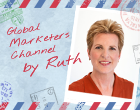マーケティングキャンパス 基礎から実践までB2Bマーケティングを学ぶサイト
ホーム > コラム > ルース教授のグローバル講座 ─Global Marketers Channel by Ruth─ > 有効なリード基準を定義するために必要な4つのヒント─How to develop effective lead qualification criteria─
2019.11.25

有効なリード基準を定義するために必要な4つのヒント
─How to develop effective lead qualification criteria─
グローバル担当者向け
有望なリードを絞り込むための基準は、セールスマネージャーまたはトップセールスなど、営業と一緒に議論して設定することが大切です。ただし、営業はすぐにでもクロージングできる案件のある見込み客を要求するため、注意が必要です。
プロセスとして、まずは彼ら(セールスマネージャーまたは経験豊富なトップセールス)と、理想的な見込み客について議論し、そのリードを絞り込み、アプローチするまでに重要となるいくつかの指標をリストします。その中から、現実的かつ営業のニーズも満たしている、最も生産性の高い指標を決定します。
クラウド型ファイル共有ソフトをエンタープライズ規模の顧客にライセンス販売する企業のケースを、例に挙げて考えてみましょう。
営業に、「あなたにとって、理想的な見込み客を教えてください」と質問したとします。営業は、「ビジネスにインパクトを与えたいと考えている、かつ戦略的でビジョンがあり、さらに企業のソフトウェアがクラウドに移行していることを理解している人」と答えるかもしれません。
これだけでは絞り込みが難しいため、この理想的な見込み客に関する詳細情報を検討する必要があります。
必要なものは、例えば下記の様な情報になります。
規模企業、従業員数、売上高
ターゲット業界、役職
見込み客のビジョンや戦略などを定義することは、簡単ではありません。この場合、顧客が置かれていると思われる環境について議論する方が生産的です。例えば、対象企業が現在クラウドベースの他のソフトウェアやサービスを使用しているかどうかについてのyes/noの質問は、顧客が新しいサービスや技術を採択するかどうか判断できる基準でもあり、強力な指標です。その他の絞り込み基準は、会社規模や業界、現在のクラウドコンピューティング利用の有無といったところになるでしょう。
ここで、有望なリードを絞り込むのためのヒントをご紹介します。
Web、音声、または紙であるかにかかわらず、フォームで絞り込みに有効な質問をします。問い合わせの時点で情報を収集することは、回答率低下の一因となる一方、より精度の高い絞り込みが可能になります。
見込み客に、営業活動に必要な全ての質問をします。これらは、案件化率や受注率に影響します。
フォームに、「営業担当者からの連絡希望」といった、少しハードルの高いチェックボックスを設けます。営業担当者が連絡できる希望時間を入れてもらうことができれば、なお良いでしょう。
キャンペーン全体を通して、一貫性のある基準を設定します。すべてのキャンペーンに対してオリジナルの基準を設定するのではなく、製品ラインに活かせる3,4個の質問を設定して、合意を目指します。これができれば、リストやオファー、クリエイティブなど、キャンペーンに関する変数に対して、中長期的に結果を分析することができます。この戦略により、キャンペーンプランニング時に起こる混乱や無駄な業務を減らしていくことができるでしょう。
ルース・スティーブンス プロフィール
アメリカのBtoBマーケティングを代表するコンサルタント
コロンビア大学客員教授。イーマーケティングストラテジー社 代表取締役。
コロンビア大学経営大学院卒業、MBA取得。タイム・ワーナー社、ジフ・デイビス社、IBM社などでマーケティングの要職を歴任。米国のBtoBマガジンで最も影響力のある100人のひとり、またリードマネジメント協会の注目すべき女性20人にも選ばれている。数多くのメディアにもブロガーとして寄稿し、B2Bマーケティングをテーマにした多くの著書がある。
The best way to develop qualification questions is to set the criteria in concert with your sales team. Sit down with a couple of sales managers or a few top sales reps. Don’t take everything they say as gospel─or they’ll insist that you deliver only leads that are going to close tomorrow.
Spend some time with a sales manager or a few senior experienced sales reps, and ask them to describe their ideal prospect. You might ask them for five critically important, must-have characteristics to qualify and pursue a prospect. Select from the picture they paint the categories that will be the most productive─and those where you can realistically gather the information—and then determine the range of answers that fit their needs.
Here’s how such a conversation might go with a sales force charged with selling enterprise-wide licensing deals for a file-sharing software-as-a-service. You say, “Describe your ideal prospect.” They say, “We want to find a strategic, visionary person, who wants to have an impact on the business and understands that enterprise software is moving to the cloud.” How can you convert this description to a reasonable set of qualifying questions? Based on what you have so far, not easily. You need to back up and probe further. So you might ask questions like:
How big an enterprise are you looking for? How many employees? What kind of revenue levels?
What industries are you targeting? Have you gotten traction in particular industries?
What titles are these visionary people likely to have?
You know it’s difficult to assess the prospect’s vision or aptitude for innovation with a standard question. So in this case, it is likely more productive to ask questions about the current environment. For example, a yes/no question about whether the target company is using cloud-based software anywhere in the corporation might be a reasonable proxy for the degree of new-technology adoption and, in fact, a strong indicator that another cloud-based application might find a home there. The final list of qualification questions might be around company size, industry and current cloud computing usage.
Some other tips for success with qualification questions:
Ask your qualification questions on your response forms, whether they are web based, by voice, or paper based. Asking questions at the point of inquiry collection will most likely reduce campaign response rates, but you can make it up in increased qualification rates, which saves money in the long run by reducing outbound qualification effort.
Ask prospects all the questions the sales team needs to do its job. If you don’t ask, your sales conversion rates will fall dramatically.
Include a hard option such as “have a sales specialist contact me” as a check-off box on every form. You might even go further by asking what the best time would be for the rep to make contact.
Set criteria that are used consistently across campaigns. Instead of developing original criteria for every campaign, try to gain agreement on a few─three or four─basic questions that apply across your product lines. If you can pull this off, you can analyze results over time and across campaign variables such as list, offer, and creative. This strategy also reduces confusion and extra work during campaign planning.
Ruth P. Stevens Bio
Ruth P. Stevens consults on customer acquisition and retention, teaches marketing at business schools in the U.S. and abroad, and is a guest blogger at Biznology and Target Marketing Magazine, and a contributing writer at AdAge. Crain’s BtoB magazine named Ruth one of the 100 Most Influential People in Business Marketing. Her newest book is B2B Data-Driven Marketing: Sources, Uses, Results. Ruth has held senior marketing positions at Time Warner, Ziff-Davis, and IBM and holds an MBA from Columbia University. Learn more at www.ruthstevens.com.